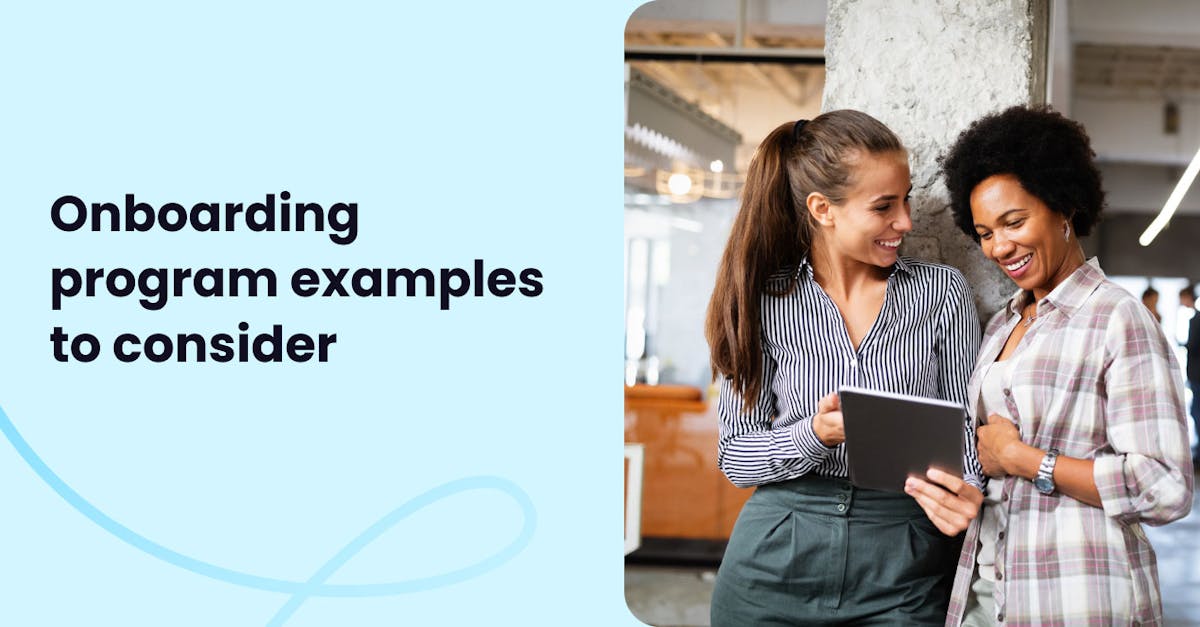10 Onboarding program examples to consider

Creating a successful onboarding program is crucial for ensuring that new employees feel welcomed and ready to contribute. The primary objective of an onboarding program is to familiarize new hires with the company, their role, and their responsibilities. In this article, we’ll discuss ten exemplary onboarding program examples that you can implement.
Onboarding Program Example #1 - Company Culture Onboarding
One of the most critical aspects of any onboarding program is introducing new hires to your unique company culture. Your company culture encompasses your vision, values, work ethics, and the overall atmosphere of your workplace. To bring your culture to life, consider hosting interactive training sessions where you share your company's strategies, goals, and behavioral expectations.

But don't stop there. Show genuine support and interest by assigning an onboarding buddy, asking meaningful questions, and being open to feedback. It's these human connections that transform new hires into long-term team members who truly understand and embrace your company culture.
EdApp can help streamline the process of introducing new hires to your company culture through interactive training modules, quizzes, and engaging content that fosters a sense of belonging.
Tired of outdated onboarding processes? Make training fun for your new hires by signing up for EdApp today!
Onboarding Program Example #2 - Introductions and IceBreakers
First impressions matter, and that's why it's essential to prioritize introductions and icebreakers during the onboarding process. Help new hires feel welcomed and included from the start by organizing team meetings where they can meet their colleagues and establish connections. Even if your team is geographically dispersed, technology can bridge the gap.

Consider virtual icebreaker activities like Team Trivia, where everyone shares a fun fact about themselves or a questionnaire where new hires can share their interests and hobbies. By creating opportunities for personal connections, you set the stage for a collaborative and inclusive work environment.
Onboarding Program Example #3 - Onboarding Buddies/Mentors
New employees often feel overwhelmed as they navigate their new roles and responsibilities. To support them during this crucial period, assign an onboarding buddy or mentor. These seasoned employees serve as guides, helping new hires understand how your company operates and where they fit in. They provide ongoing feedback, identify strengths and weaknesses, and offer a listening ear when challenges arise.

Studies show that employees who have mentors become productive more quickly and experience higher job satisfaction. Including a buddy for employee development in your onboarding program example will ensure that new hires feel supported and empowered.
Onboarding Program Example #4 - New Hire Workshops
To disseminate essential information to a group of new hires, workshops are an effective choice. These interactive sessions can cover policies, HR processes, safety rules, and other crucial details that benefit a larger cohort of employees. Workshops provide a platform for open discussion, where new hires can ask questions and interact with subject matter experts.

Additionally, make sure to provide easily accessible resources and materials for future reference. By incorporating workshops into your onboarding program example, you ensure consistent knowledge transfer and a shared understanding of vital information.
Onboarding Program Example #5 - Onboarding Gamification
Why not make onboarding fun and engaging by incorporating gamification elements into your onboarding programs? Gamification adds a level of excitement and motivation to the process. Consider using an onboarding LMS and introducing badges, points, or levels for completing training modules, achieving specific milestones, or demonstrating desired behaviors.

This approach transforms onboarding into a game, where employees can track their progress, compete with colleagues, and earn rewards. However, it's important to strike a balance and avoid excessive monitoring to ensure employees don't feel overwhelmed or micromanaged. By incorporating gamification into your onboarding program example, you create an interactive and enjoyable experience for new hires.
EdApp is renowned for its onboarding gamification features, so using it throughout the onboarding process will thoroughly incorporate this feature into your processes.
Onboarding Program Example #6 - Team Lunches
Building connections among new hires is vital for creating a supportive and collaborative work environment. Organize company-paid lunches where new hires can meet their immediate team, colleagues from their department, or collaborators from other teams. These informal gatherings provide an opportunity for new hires to get to know their coworkers on a personal level, share experiences, and build relationships.

For remote or hybrid workers, consider sending them gift cards for meal delivery by EveryPlate and arranging virtual lunches with video calls. To make these virtual lunches more engaging, incorporate trivia games or ice breaker activities to spark conversations and help new hires learn about the company's history and culture.
Onboarding Program Example #7 - In-Person Training for Remote Employees
While remote work is becoming increasingly prevalent, there's still value in providing in-person training opportunities, especially during the initial onboarding phase. If feasible, consider bringing remote employees to your headquarters for immersive training experiences. This face-to-face interaction nurtures their sense of belonging, allows them to meet colleagues in person, and helps them better understand the office culture.

For virtual onboarding, ensure that all team meetings include video calls, encourage the use of project management software for collaboration, and provide access to instant messaging platforms. These practices create an inclusive onboarding experience and foster a cohesive company culture, regardless of physical location.
Onboarding Program Example #8 - Product Samples Kit
Beyond the usual welcome kit, why not offer new employees a taste of the products or services your company provides? Providing samples allows them to familiarize themselves with what your company offers, from features to unique selling points. Encourage them to explore, ask questions, and share their feedback.

This hands-on experience not only deepens their understanding of your offerings but also makes them feel valued and involved in shaping the company's future. Incorporating product samples into your onboarding program example engages new hires and gives them a tangible connection to their new workplace.
Onboarding Program Example #9 - Social Media Onboarding
In the digital age, social media platforms offer powerful tools for onboarding new hires. Establish a strong public social media presence for your company, and consider creating an invitation-only page dedicated to new hires. Use these platforms to share exciting company updates, photos of events, employee achievements, and insights into your company culture.

Encourage new hires to engage with the content, ask questions, and connect with their colleagues through social media channels. By utilizing social media in your onboarding program example, you provide new hires with additional touchpoints to learn about your company, stay informed, and feel connected to the broader organization.
Onboarding Program Example #10 - Onboarding Surveys
Continuous improvement is key to a successful onboarding program. To gather valuable feedback, implement onboarding surveys. These surveys allow you to assess the effectiveness of your program and make necessary adjustments. Design surveys that evaluate new hires' connection to your company's mission, values, and culture.

Assess their engagement with onboarding activities and their integration into their teams. Measure their overall satisfaction and likelihood of recommending your company as a great place to work. Analyze the feedback to identify trends and areas for improvement. By seeking feedback, you demonstrate your commitment to enhancing the learning experience and ensuring the long-term success of your employees.
EdApp provides a user-friendly survey tool that allows you to easily create and distribute onboarding surveys, facilitating the collection and analysis of feedback to continuously enhance your onboarding process.
Conclusion
To sum it up, an effective onboarding program plays a crucial role in ensuring new employees feel valued, ready, and motivated. With its wide range of features and user-friendly interface, EdApp offers an ideal solution for simplifying and enriching your onboarding process. Whether it's creating engaging training modules or facilitating communication and feedback through surveys, EdApp empowers organizations to provide a smooth and immersive onboarding journey.
Author
Guest Author Gavoy Small
Gavoy Small is a guest author at EdApp who specializes in ESL Teaching, Content Production, and Customer Service.
